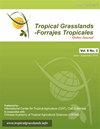施用有机肥料是Piatã草合成肥料的可行替代品吗?
IF 0.7
4区 农林科学
Q3 AGRICULTURE, DAIRY & ANIMAL SCIENCE
引用次数: 1
摘要
在许多情况下,有机肥料可以取代矿物肥料,从而降低生产成本并改善土壤质量。因此,这项工作的目的是评估一年中施用尿素、有机堆肥和生物肥料的Piatã草(Urochloa brizantha)的生产、形态和结构特征。试验设计是时间(季节)设计中的块分割区,有4个处理(尿素、有机堆肥、生物肥料和对照)和6次重复。评价的参数为:干物质产量(DMP)、叶片伸长率(LER)、叶片出现率(LAR)、叶龄(PHYL)、叶片寿命(LLS)、假茎伸长率(SER)、最终叶长(FLL)、活叶数(NLL)和分蘖数(NT)。尿素处理的LAR值在夏季和春季最高,这也产生了最高的LER值。不同施肥处理之间的SER没有差异,但所有施肥处理都优于对照。尿素处理的NT和DMP值最高(P<0.05),其次是生物肥料、有机堆肥和对照。总之,虽然尿素的使用提供了最大的饲料产量,但施用生物肥料比有机堆肥的产量更高。应评估有机肥料的其他效益以及有机肥料和无机肥料的组合。本文章由计算机程序翻译,如有差异,请以英文原文为准。
Is organic fertilizer application a viable alternative to synthetic fertilizer for Piatã grass?
Organic fertilizer in many cases can replace mineral fertilizers and in consequence reduce production costs and improve soil quality. Thus, the aim of this work was to evaluate productive, morphogenic and structural characteristics of Piatã grass (Urochloa brizantha) fertilized with urea, organic compost and biofertilizer throughout a year. The trial design was a block split-plot in time (seasons) design with 4 treatments (fertilizing with urea, organic compost, biofertilizer and Control) and 6 repetitions. The evaluated parameters were: dry matter production (DMP), leaf elongation rate (LER), leaf appearance rate (LAR), phyllochron (PHYL), leaf lifespan (LLS), pseudostem elongation rate (SER), final leaf length (FLL), number of live leaves (NLL) and number of tillers (NT). The highest LAR values were observed during summer and spring for the treatment with urea, which also produced the highest LER values. No difference was found in SER among the fertilizer treatments but all fertilized treatments were superior to Control. NT and DMP values were highest (P<0.05) in the treatment with urea, followed by biofertilizer, organic compost and Control. In conclusion, while the use of urea provided greatest forage production, applying biofertilizer gave superior yields to organic compost. Other benefits of organic fertilizers should be assessed as well as combinations of organic and inorganic fertilizers.
求助全文
通过发布文献求助,成功后即可免费获取论文全文。
去求助
来源期刊

Tropical Grasslands-Forrajes Tropicales
Agricultural and Biological Sciences-Agronomy and Crop Science
CiteScore
1.60
自引率
0.00%
发文量
36
审稿时长
16 weeks
期刊介绍:
The Journal publishes, in English or Spanish, Research Papers and Short Communications on research and development, as well as contributions from practitioners (Farmer Contributions) and Review Articles, related to pastures and forages in the tropics and subtropics. There is no regional focus; the information published should be of interest to a wide readership, encomprising researchers, academics, students, technicians, development workers and farmers.
In general, the focus of the Journal is more on sown (''improved'') pastures and forages than on rangeland-specific aspects of natural grasslands, but exceptions are possible (e.g. when a submission is relevant for a particularly broad readership in the pasture and forage science community).
The Journal will also consider the occasional publication of associated, but closely related, research in the form of an additional scientific communication platform [e.g. a re-make of the former Genetic Resources Communication series of the former Division of Tropical Crops and Pastures of the Commonwealth Scientific and Industrial Research Organisation (CSIRO), Australia].
Areas of particular interest to the Journal are:
Forage Genetic Resources and Livestock Production[...]
Environmental Functions of Forages[...]
Socio-economic Aspects[...]
Topics within the aforementioned areas may include: Diversity evaluation; Agronomy; Establishment (including fertilization); Management and utilization; Animal production; Nutritive value; Biotic stresses (pests and diseases, weeds); Abiotic stresses (soil fertility, water, temperature); Genetics and breeding; Biogeography and germplasm collections; Seed production; Ecology; Physiology; Rhizobiology (including BNF, BNI, mycorrhizae); Forage conservation; Economics; Multilocational experimentation; Modelling.
 求助内容:
求助内容: 应助结果提醒方式:
应助结果提醒方式:


